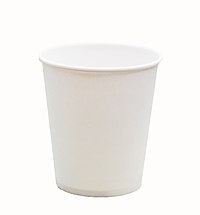Copo de papel
UM Copo de papel is a copo descartável made out of paper and often lined or coated with plastic ou wax to prevent liquid from leaking out or soaking through the paper.[1][2][3] It may be made of recycled paper[4] and is widely used around the world.
História[editar]
Paper cups have been documented in imperial China, where paper was invented by 2nd century BC.[5] Paper cups were known as chih pei and were used for the serving of tea.[6] Eles foram construídos em diferentes tamanhos e cores, e foram adornados com desenhos decorativos. Evidência textual de copos de papel aparece em uma descrição dos bens da família Yu, from the city of Hangzhou.[6]
O copo de papel moderno foi desenvolvido no século 20. No início do século 20, era comum compartilhar copos ou bacias em fontes de água, como torneiras de escolas ou barris de água em trens. Este uso compartilhado causou preocupações de saúde pública. Uma investigação notável sobre seu uso foi o estudo de Alvin Davison, biology professor at Lafayette College, publicado com o título sensacional “Morte em copos escolares” in Technical World Magazine in August 1908, based on research carried out in Easton, Pennsylvania‘s public schools. O artigo foi reimpresso e distribuído pelo Conselho Estadual de Saúde de Massachusetts em novembro 1909.[7]
Com base nessas preocupações, e como produtos de papel (especialmente depois do 1908 invenção da Copa Dixie) tornou-se disponível de forma barata e limpa, proibições locais foram aprovadas no copo de uso compartilhado. One of the first railway companies to use disposable paper cups was the Lackawanna Railroad, que começou a usá-los em 1909. Por 1917, o vidro público havia desaparecido dos vagões ferroviários, substituídos por copos de papel, mesmo em jurisdições onde os óculos públicos ainda não tinham sido proibidos.[8]
Copos de papel também são usados em hospitais por motivos de saúde. Em 1942 o Massachusetts State College descobriu em um estudo que o custo do uso de óculos laváveis, reutilizado depois de higienizado, era 1.6 vezes o custo do uso de copos de papel descartáveis.[9] Esses estudos, bem como a redução do risco de infecção cruzada, incentivou o uso de copos de papel em hospitais.
Dixie cups[editar]
Dixie Cup is the brand name for a line of disposable paper cups that were first developed in the United States in 1907 by Lawrence Luellen, a lawyer in Boston, Massachusetts, who was concerned about germs being spread by people sharing glasses or dippers at public supplies of drinking water. Luellen developed an ice-cooled water-vending machine with disposable cups,[7] and with another Bostonian, Hugh Moore, embarked on an advertising campaign to educate the public and to market his machine, principally to railroad companies. Professor Davison’s study was instrumental in abolishing the public glass and opening the door for the paper cup. Soon, the devices, which would dispense cool water for one cent, became standard equipment on trains.
The Dixie Cup was first called “Cupom de Saúde”, but from 1919 it was named after a line of dolls made by Alfred Schindler’s Dixie Doll Company in New York. Success led the company, which had existed under a variety of names, to call itself the Dixie Cup Corporation and move to a factory in Wilson, Pennsylvania. Atop the factory was a large water tank in the shape of a cup.[10]
Em 1957, Dixie merged with the American Can Company. The James River Corporation purchased American Can’s paper business in 1982. The assets of James River are now part of Georgia-Pacific, a subsidiary of Koch Industries, the second largest privately owned company in the United States. Em 1983, production moved to a modern factory in Forks, Pennsylvania. The original factory in Wilson has sat vacant ever since. The closing of the factory also prompted Conrail to abandon the Easton & Northern railroad branch, of which Dixie Cups was the last major customer.
Em 1969, the Dixie Cup logo was created by Saul Bass, a graphic designer known for his motion picture title sequences.
The coupon collector’s problem is sometimes called the Dixie cup problem.
Fabricação[editar]

The world’s largest “papel” cup in front of what was once the Lily-Tulip manufacturing company, later Sweetheart Cup Company.[11] Made of poured concrete, the cup stands about 68.1 feet (20.8 m) tall.
The base paper for paper cups are called “armário” and are made on special multi-ply paper machines and have a barrier coating for waterproofing. The paper needs high stiffness and strong wet sizing. The cup board grades have a special design for the cup manufacturing processes. O processo de formação de rolos de boca requer boas propriedades de alongamento da placa e do revestimento plástico. A well formed mouth roll provides good stiffness and handling properties in the cup. The basis weights of the cup boards are 170–350 g/m2.[12]
Para atender aos requisitos de higiene, copos de papel são geralmente fabricados a partir de virgem (não reciclado) materiais.[citation needed] The one exception to this rule is when the paper cup features an extra insulating layer for heat retention, que nunca entra em contato com a bebida, such as a corrugated layer wrapped round a single-wall cup.
Impermeabilização[editar]
Originalmente, copos de papel para bebidas quentes foram colados e impermeabilizados colocando uma pequena quantidade de argila no fundo do copo, e depois girando em alta velocidade para que a argila subisse pelas paredes do copo, tornando o papel resistente à água. No entanto, isso resultou em bebidas com cheiro e gosto de papelão.
Copos para bebidas geladas não poderiam ser tratados da mesma forma, à medida que se forma condensação no exterior, em seguida, penetra no tabuleiro, tornando o copo instável. Para remediar isso, fabricantes de copos desenvolveram a técnica de borrifar cera no interior e no exterior do copo. Clay- and wax-coated cups disappeared with the invention of polietileno (Educação Física)-copos revestidos; este processo cobre a superfície da placa com uma camada muito fina de PE, impermeabilizando a placa e soldando as costuras.
Impressão em copos de papel[editar]
Originalmente, os copos de papel eram impressos com blocos de borracha montados em cilindros., com um cilindro diferente para cada cor. O registro em cores diferentes foi muito difícil, but later flexography plates became available and with the use of mounting systems it became easier to register across the colours, permitindo projetos mais complexos. A impressão flexográfica tornou-se ideal para tiragens longas e os fabricantes geralmente usam esse método ao produzir mais de um milhão de xícaras. Machines such as Comexi are used for this, que foram adaptados para suportar as bobinas extra grandes exigidas pelos fabricantes de copos de papel. Ink technology has also changed and where solvent-based inks were being used, tintas à base de água estão sendo utilizadas. Um dos efeitos colaterais das tintas à base de solvente é que os copos de bebidas quentes, em particular, podem cheirar a solvente, Considerando que as tintas à base de água eliminaram este problema. Other methods of printing have been used for short runs such as offset printing, which can vary from anything from 10,000 para 100,000 xícaras. Tintas de impressão offset também foram desenvolvidas e embora no passado fossem à base de solvente, the latest soya-based inks have reduced the danger of cups smelling. The latest development is Direct-printing, que permite imprimir em quantidades muito pequenas, normalmente de 1,000 xícaras, and is used by companies including The Paper Cup Company offering small quantities in short lead times. Rotogravure can also be used, mas isso é extremamente caro e normalmente só é utilizado para itens que exigem impressão de qualidade extremamente alta, como recipientes de sorvete.
Environmental impact[editar]
Recycling[editar]
Most paper cups are designed for a single use and then disposal. Very little recycled paper is used to make paper cups because of contamination concerns and regulations. Since most paper cups are coated with plastic (polietileno), then both composting and recycling of paper cups is uncommon because of the difficulty in separating the polyethylene in the recycling process of said cups. As of 2016, there are only two facilities in the UK able to properly recycle PE-coated cups; in the absence of such facilities, the cups are taken to landfill, ou, at best, incinerated.
A UK-based business group James Cropper have developed the world’s first facility for the effective recycling of the estimated 2.5 billion paper coffee cups used and disposed of by British businesses each year, and have become one of 14 international companies to formally join the Paper Recovery and Recycling Group (PCRRG).
James Cropper’s Reclaimed Fibre Facility was opened by HM The Queen in July 2013, and recovers both the plastic and paper from the cups; ensuring nothing is wasted from the recycling process.[13] Although paper cups are made from renewable resources (wood chips 95% by weight), paper products in a landfill might not decompose, or can release methane, if decomposed anaerobically.
A Newport Beach, CA company, Smart Planet Technologies has developed a process for modifying the polyethylene coating on paper cups and folding cartons so they are engineered for recyclability. Orange Coast College in Costa Mesa, CA has begun a program to use cups made with this technology to capture and sell the fibers to fund scholarships for their students. [14]
The manufacture of paper usually requires inorganic chemicals and creates water effluents. Paper cups may consume more non-renewable resources than cups made of polystyrene foam (whose only significant effluent is pentane).[15][16]
Papel versus plástico[editar]
UM life cycle inventory of a comparison of paper vs plastic cups shows environmental effects of both with no clear winner.[17]
Polietileno (Educação Física) is a petroleum-based coating on paper cups that can slow down the process of biodegrading of the paper it coats.
Ácido polilático (PLA) is a biodegradable bio-plastic coating used on some paper cups. PLA is a renewable resource and is certified compostable, o que significa que quando se biodegrada, não deixa resíduos tóxicos.[18] PLA-lined cups are thus the only paper cups which can be composted fully. All paper cups can only be recycled at a specialised treatment facility regardless of the lining.[19]
A number of cities – including Portland, Oregon — have banned XPS foam cups in take-out and fast food restaurants.[20]
Emissions[editar]
A study of one paper coffee cup with sleeve (16 ounce) shows that the CO2 emissions is about 0.11 kilograms (0.24 lb) per cup with sleeve – including paper from trees, materiais, production and shipping.[21]
Habitat-loss trees used[editar]
The habitat loss from one 16 ounce paper coffee cup with a sleeve is estimated to be 0.09 square meters (0.93 square feet).[dubious ][22][unreliable source?] Over 6.5 million trees were cut down to make 16 billion paper coffee cups used by U.S. in 2006, using 4 billion US gallons (15,000,000 m3) of water and resulting in 253 million pounds (115,000,000 kg) of waste. Overall, US Americans use 58% of all paper cups worldwide, amounting to 130 billion cups.[13][unreliable source?][23][unreliable source?]
Tampas[editar]
Os copos de papel podem ter vários tipos de tampas. The paper cups that are used as containers for yogurt, por exemplo, geralmente têm dois tipos de tampas: a plastic press-on, resealable, lid used for large “tamanho da família” recipientes, 250–1.000ml (8–30 fl oz americanos), where not all of the yogurt may be consumed at any one time and thus the ability to re-close the container is required and heat-seal foil lids used for small “porção única” recipientes, 150–200 ml (5–7 EUA fl oz).[24]
Bebidas quentes vendidas em copos de papel podem vir com tampa de plástico, para manter a bebida quente e evitar derramamento. These lids have a hole through which the drink can be sipped. As tampas de plástico podem ter muitos recursos, incluindo abas destacáveis, paredes elevadas para proteger a espuma de bebidas quentes gourmet e texto em relevo.[25] Em 2008, Starbucks introduced shaped plastic “bastões de respingos” para bloquear o buraco, em algumas de suas lojas, depois de reclamações de clientes sobre respingos de café quente.[26][27]
 Máquina de copo de papel Feenot
Máquina de copo de papel Feenot





